Norwegian Air Shuttle Bundle
How Does Norwegian Air Shuttle Fly High in a Competitive Market?
Norwegian Air Shuttle, a leading low-cost airline, has redefined air travel with its commitment to affordability and a modern brand identity refresh in March 2024. From its humble beginnings to its current status as a major player, the company's journey is a testament to strategic vision. This exploration dives deep into the Norwegian Air Shuttle SWOT Analysis, revealing the core elements of its success.
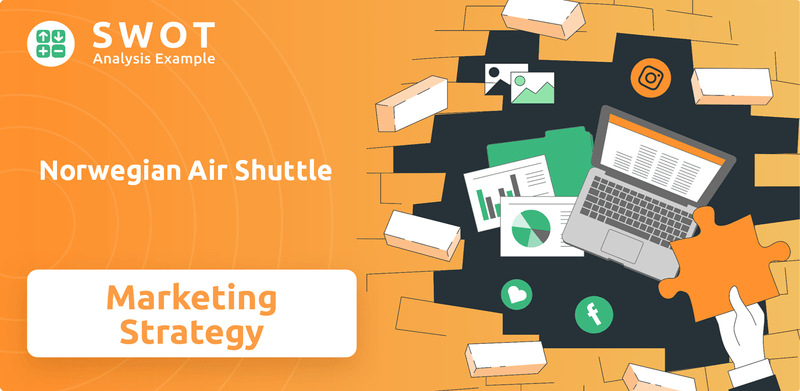
Understanding the intricate details of Norwegian Air Shuttle's sales strategy and marketing strategy is key to appreciating its achievements. This includes a close look at its digital marketing tactics, customer acquisition cost, and how it attracts customers. We'll also examine its brand positioning strategy, Norwegian Air Shuttle marketing campaigns, and how it manages its revenue in a fiercely competitive industry. Moreover, we will analyze its expansion strategy and route optimization to understand its market share analysis.
How Does Norwegian Air Shuttle Reach Its Customers?
The sales and marketing strategy of Norwegian Air Shuttle centers on a digital-first approach, primarily utilizing online channels to reach its customer base. This strategy emphasizes direct sales through its website and mobile app to reduce distribution costs. This focus allows the airline to offer more competitive fares.
The company's website serves as a central hub for ticket sales, route information, and managing bookings. Complementing this is the 'Norwegian Travel Assistant' mobile application, which saw fluctuating weekly downloads in Q3 2024. These downloads started at approximately 5.1K and ended at around 3.8K, with active users ranging from 12.2K to 10.7K. While third-party online travel agencies are also used, Norwegian Air Shuttle prioritizes direct bookings for greater control and cost efficiency.
The evolution of these sales channels reflects a shift towards a more streamlined, digital-centric model, especially after its restructuring and focus on a short-haul network post-2021. This strategic shift prioritizes direct-to-consumer engagement, allowing the airline to offer more competitive fares by minimizing intermediary costs. The focus remains on accessible online platforms and strategic collaborations to enhance customer reach and loyalty. Learn more about the Revenue Streams & Business Model of Norwegian Air Shuttle.
Norwegian Air Shuttle's primary sales channel is its own website, where customers can directly book flights and manage their travel. The mobile app, 'Norwegian Travel Assistant,' also plays a significant role, offering a convenient platform for bookings and travel management. This approach allows for direct customer engagement and cost control.
While Norwegian Air Shuttle emphasizes direct sales, it also utilizes third-party online travel agencies (OTAs) to broaden its reach. These OTAs provide additional visibility and access to a wider customer base. This multi-channel approach helps to maximize sales.
The 'Norwegian Travel Assistant' app is a key component of the company's digital strategy. The app's fluctuating weekly downloads in Q3 2024, starting at approximately 5.1K and ending at around 3.8K, with active users ranging from 12.2K to 10.7K, highlight its importance in customer engagement. It provides a seamless experience for booking, managing flights, and accessing travel information.
The acquisition of Widerøe in 2024 expanded Norwegian Air Shuttle's reach, integrating Widerøe's regional network and passenger base, which recorded 3.8 million passengers in 2024. This strategic move has significantly contributed to growth and market share, especially in Norway, where Norwegian now holds over 50% market share. This shows a focus on strategic growth and market penetration.
Norwegian Air Shuttle's sales strategy focuses on direct online sales and strategic partnerships to maximize revenue and control costs. The emphasis is on digital platforms and strategic collaborations to enhance customer reach and loyalty. This approach is crucial for the airline's competitive positioning and financial performance.
- Direct Bookings: Prioritizing direct bookings through the website and app for cost efficiency.
- Mobile App: Utilizing the 'Norwegian Travel Assistant' app for bookings, management, and customer engagement.
- Strategic Partnerships: Leveraging acquisitions, like Widerøe, to expand market reach and passenger base.
- Digital Marketing: Implementing digital marketing tactics to attract customers.
Norwegian Air Shuttle SWOT Analysis
- Complete SWOT Breakdown
- Fully Customizable
- Editable in Excel & Word
- Professional Formatting
- Investor-Ready Format
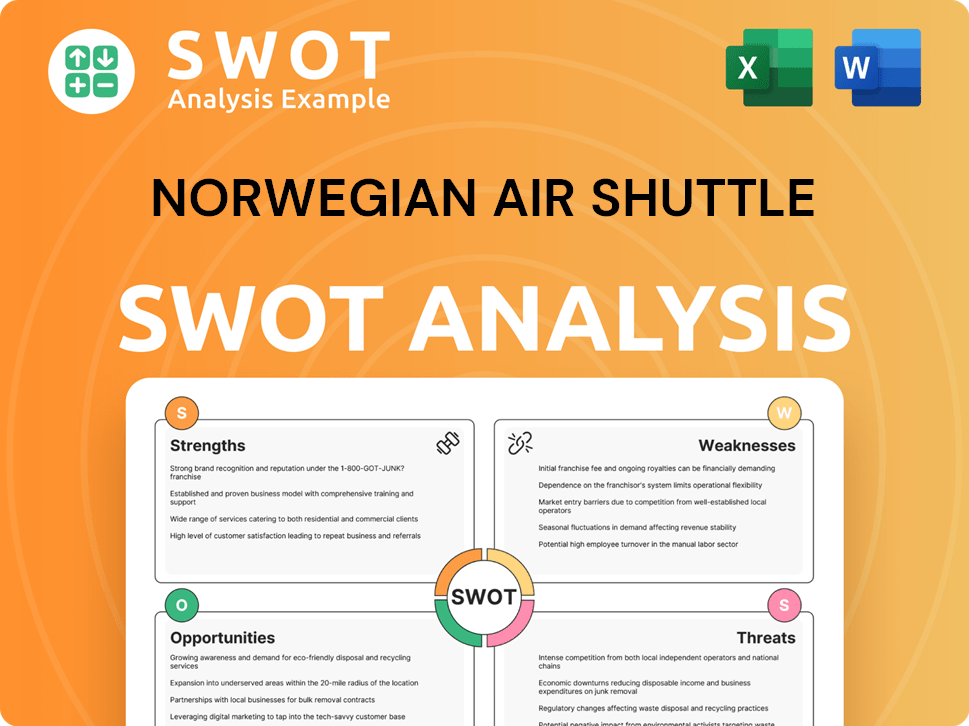
What Marketing Tactics Does Norwegian Air Shuttle Use?
The marketing tactics of the airline are heavily geared towards digital channels to boost awareness, generate leads, and drive sales. This approach includes content marketing, highlighting affordable fares, an extensive route network, and the 'smart travel' experience. The airline's focus on increasing direct sales through its website and app suggests significant investment in optimizing online visibility and conversions.
Email marketing and social media platforms are crucial for direct customer communication, promoting deals, new routes, and loyalty program benefits. The launch of 'Spenn,' a loyalty platform developed with Strawberry in November 2024, shows a strong emphasis on customer retention and personalized offers. The marketing department, led by EVP Market and Customer Service Christoffer Sundby and Creative Director Camilla Aspen, collaborated with Try Design for their 2024 brand refresh, indicating a commitment to modern and effective visual communication across all channels.
The airline also employs data-driven marketing and customer segmentation, evident in its efforts to increase corporate agreements. In 2024, over 3,000 new corporate agreements were signed, resulting in a 50% increase in corporate travel revenues from 2019 to 2024. This strategy allows the airline to target specific customer segments effectively.
The airline prioritizes digital channels for marketing. This includes content marketing to showcase its value proposition and drive direct sales through its website and app.
Email marketing and social media are key for direct customer engagement. These channels promote deals, new routes, and loyalty program benefits, fostering customer relationships.
The launch of the 'Spenn' loyalty platform in November 2024, developed with Strawberry, highlights a focus on customer retention. This platform offers personalized offers.
The brand refresh in 2024, in collaboration with Try Design, demonstrates a commitment to modern and effective visual communication. This ensures consistent messaging across all channels.
The airline uses data-driven marketing to target specific customer segments. This includes increasing corporate agreements, leading to significant revenue growth.
The company signed over 3,000 new corporate agreements in 2024. Corporate travel revenues increased by 50% from 2019 to 2024, highlighting the effectiveness of this strategy.
The airline's marketing strategy is multifaceted, with a strong emphasis on digital channels, customer engagement, and data-driven insights. The focus on direct sales through digital platforms, coupled with targeted customer segmentation, supports the airline's revenue goals. The integration of a loyalty program and a modern brand refresh further enhances its customer-centric approach. The airline's marketing efforts are designed to support its overall business model by attracting customers and driving sales.
The airline utilizes various marketing tactics to reach and engage its target audience. These tactics are designed to drive sales and build brand loyalty.
- Digital Marketing: Focus on content marketing, SEO, and paid advertising to increase online visibility and direct sales.
- Email Marketing and Social Media: Direct communication with customers to promote deals, new routes, and loyalty program benefits.
- Loyalty Program: 'Spenn' platform to enhance customer retention and provide personalized offers.
- Brand Refresh: Modern visual communication across all channels.
- Data-Driven Marketing: Increase corporate agreements and target specific customer segments.
- Customer Segmentation: Identify and target specific customer segments to enhance marketing effectiveness.
Norwegian Air Shuttle PESTLE Analysis
- Covers All 6 PESTLE Categories
- No Research Needed – Save Hours of Work
- Built by Experts, Trusted by Consultants
- Instant Download, Ready to Use
- 100% Editable, Fully Customizable
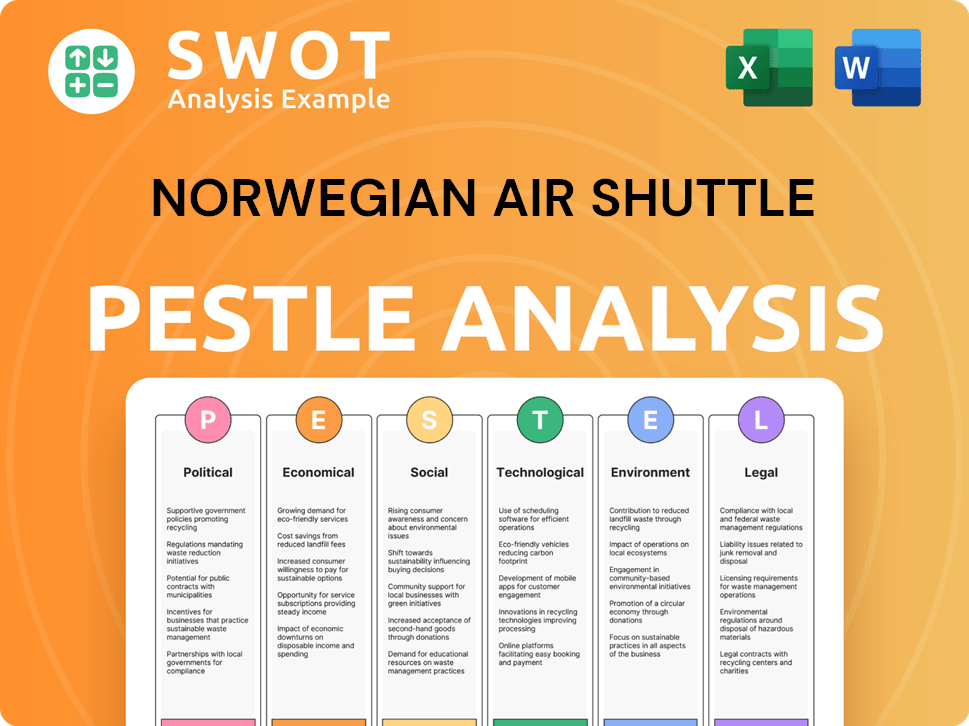
How Is Norwegian Air Shuttle Positioned in the Market?
The brand positioning of Norwegian Air Shuttle centers on being a low-cost carrier, offering affordable fares without compromising on a comfortable travel experience. This approach is fundamental to its Owners & Shareholders of Norwegian Air Shuttle strategy, differentiating it from competitors by focusing on value and efficiency. The airline's marketing strategy emphasizes its commitment to providing a reliable and predictable 'no nonsense' airline experience, appealing to a broad customer base.
A key element of Norwegian's brand identity is its 'Tail Fin Heroes' concept, which features portraits of inspiring figures on aircraft tail fins. This unique visual element, combined with the core message of 'affordable fares for all,' helps the airline stand out. This approach is crucial for its Norwegian Air Shuttle sales strategy and overall brand recognition in a competitive market.
In March 2024, the company launched a refreshed visual identity, marking the first change since its inception in 2002. This update, developed with Try Design, aimed for a more modern and clear expression. This included a richer color palette, a new font, and an updated image style. This subtle yet impactful change reinforces its commitment to modernity while maintaining brand recognition.
Norwegian Air Shuttle focuses on providing budget-friendly travel options. Its Norwegian Air Shuttle pricing strategy analysis aims to attract price-sensitive customers. The airline's business model is built around offering competitive prices to gain market share.
Despite being a low-cost carrier, Norwegian emphasizes a comfortable travel experience. This includes modern aircraft and a focus on customer satisfaction. The airline's strategy balances affordability with a positive passenger experience.
The 'Tail Fin Heroes' concept is a unique branding element. This visual identity helps differentiate the airline. It adds a layer of inspiration and cultural relevance to the brand.
The refreshed visual identity launched in 2024. This update aimed for a more modern and clear expression. The new look reinforces the airline's commitment to staying current.
The brand positioning of Norwegian Air Shuttle is built on several core elements that define its identity and appeal to its target audience. These elements work together to create a cohesive brand image that emphasizes value, efficiency, and a modern approach to air travel.
- Affordable Fares: The cornerstone of Norwegian's brand is its commitment to offering low-cost fares. This is a primary driver for attracting customers.
- Comfort and Reliability: The airline aims to provide a comfortable and reliable travel experience. This includes maintaining a modern fleet and focusing on operational efficiency.
- Unique Visual Identity: The 'Tail Fin Heroes' concept and the updated visual identity contribute to a unique brand image. This helps the airline stand out in a crowded market.
- Sustainability: Norwegian is committed to reducing its environmental impact. The goal is to become the sustainable choice for passengers. The company aims to reduce CO2 emissions by 45% by 2030.
Norwegian Air Shuttle Business Model Canvas
- Complete 9-Block Business Model Canvas
- Effortlessly Communicate Your Business Strategy
- Investor-Ready BMC Format
- 100% Editable and Customizable
- Clear and Structured Layout
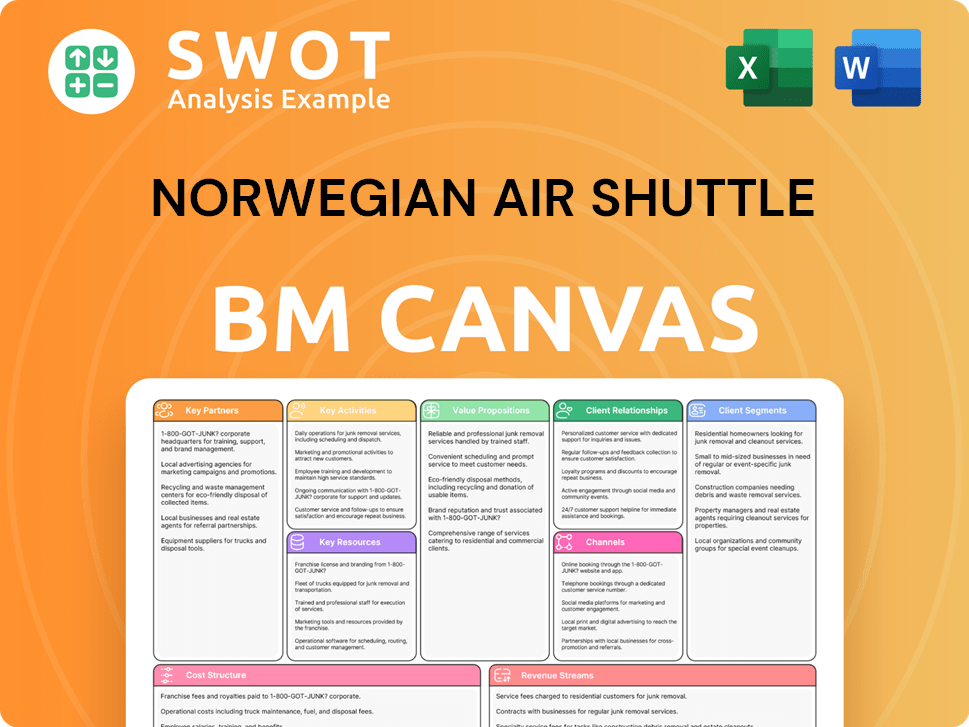
What Are Norwegian Air Shuttle’s Most Notable Campaigns?
The Norwegian Air Shuttle sales strategy and Norwegian Air Shuttle marketing strategy in 2024-2025 are centered on promoting affordable fares and expanding its route network. The company consistently focuses on enhancing the customer experience to drive sales. Key campaigns include launching ticket sales for peak travel seasons and introducing new routes to capitalize on demand.
A significant move was the acquisition of Widerøe in 2024, which bolstered passenger numbers and market share. This strategic acquisition has been a key driver of growth for the Norwegian Air Shuttle business model. Furthermore, the company has been refreshing its brand identity and launching new customer retention programs.
The Norwegian Air Shuttle marketing campaigns are designed to increase brand visibility and solidify its position as a leading low-cost carrier. These efforts aim to attract customers and improve revenue. The company also focuses on digital marketing tactics and social media strategy.
In 2024, Norwegian Air Shuttle launched ticket sales for the Summer 2024 season. This included announcing three new routes connecting Tromsø to Berlin, Milan/Bergamo, and Paris/Charles de Gaulle. This expansion aimed to capitalize on peak travel demand and expand the company's route network.
In March 2024, Norwegian Air Shuttle introduced a modernized logo and visual profile. This initiative aimed to present a more contemporary brand image. The rollout started with digital channels and will gradually extend to all communication areas, offices, airports, and aircraft.
Launched in November 2024, the 'Spenn' loyalty platform signifies a key campaign focused on customer retention and value. This platform is designed to enhance customer engagement and drive repeat business. This is a crucial part of how Norwegian Air Shuttle attracts customers.
In November 2024, the CEO highlighted encouraging booking momentum, especially for the Christmas travel season. This success was attributed to effective marketing campaigns. These campaigns contribute to Norwegian Air Shuttle revenue.
Norwegian Air Shuttle continuously evaluates its route network. This involves analyzing demand, profitability, and operational efficiency to optimize its flight paths. This is a part of its Norwegian Air Shuttle expansion strategy.
The company leverages digital channels for advertising and customer engagement. This includes social media, online advertising, and email marketing to reach its target audience. This is a part of Norwegian Air Shuttle digital marketing tactics.
Enhancing the customer experience is a priority. This includes improving onboard services, streamlining booking processes, and providing excellent customer support. This contributes to customer loyalty and repeat business.
Norwegian Air Shuttle may engage in partnerships to expand its reach and offer more services to its customers. These partnerships could include codeshares, alliances, or collaborations with travel agencies. This is a part of Norwegian Air Shuttle partnership strategies.
The 'Spenn' loyalty platform is a key component. It aims to reward frequent flyers and encourage repeat bookings. Details of the loyalty program are essential for customer retention. This is a part of Norwegian Air Shuttle loyalty program details.
Having a crisis communication plan is essential for managing unexpected events. This plan helps the company respond effectively to any issues that may arise. This is a part of Norwegian Air Shuttle crisis communication plan.
The main objectives of these campaigns are to increase sales, enhance brand visibility, and solidify the company's position in the market. The company focuses on maintaining a competitive Norwegian Air Shuttle pricing strategy analysis.
- Increase bookings and revenue.
- Improve brand recognition.
- Enhance customer loyalty.
- Expand market share.
For a deeper understanding of the company's strategic moves, you can read this article about the company's strategy: [Norwegian Air Shuttle's Strategic Overview](https://www.example.com/norwegian-air-shuttle-strategy).
Norwegian Air Shuttle Porter's Five Forces Analysis
- Covers All 5 Competitive Forces in Detail
- Structured for Consultants, Students, and Founders
- 100% Editable in Microsoft Word & Excel
- Instant Digital Download – Use Immediately
- Compatible with Mac & PC – Fully Unlocked
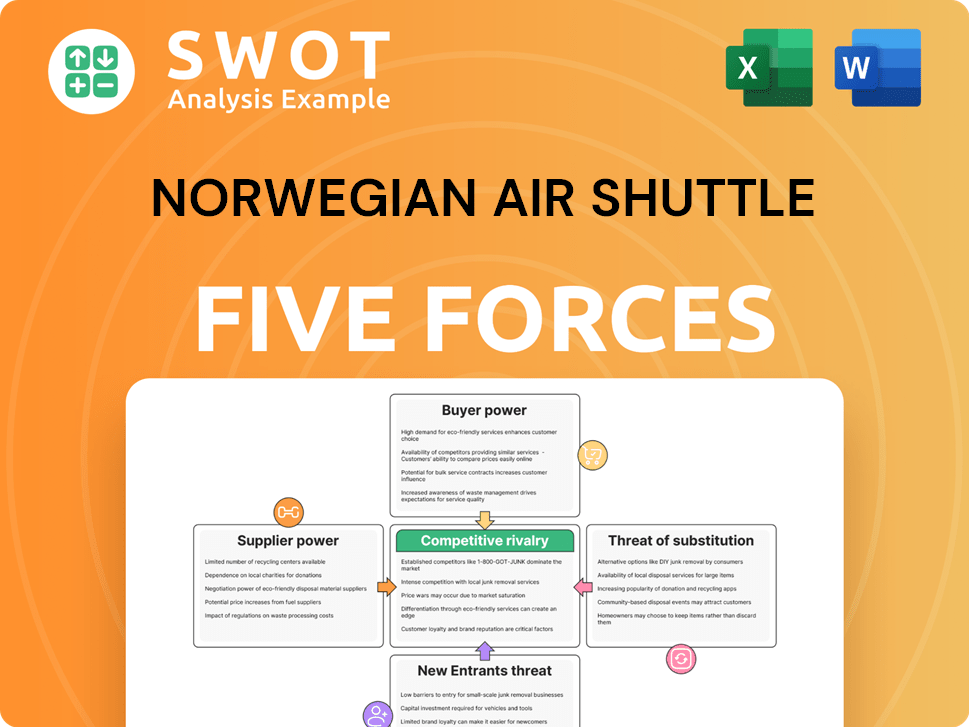
Related Blogs
- What are Mission Vision & Core Values of Norwegian Air Shuttle Company?
- What is Competitive Landscape of Norwegian Air Shuttle Company?
- What is Growth Strategy and Future Prospects of Norwegian Air Shuttle Company?
- How Does Norwegian Air Shuttle Company Work?
- What is Brief History of Norwegian Air Shuttle Company?
- Who Owns Norwegian Air Shuttle Company?
- What is Customer Demographics and Target Market of Norwegian Air Shuttle Company?
Disclaimer
All information, articles, and product details provided on this website are for general informational and educational purposes only. We do not claim any ownership over, nor do we intend to infringe upon, any trademarks, copyrights, logos, brand names, or other intellectual property mentioned or depicted on this site. Such intellectual property remains the property of its respective owners, and any references here are made solely for identification or informational purposes, without implying any affiliation, endorsement, or partnership.
We make no representations or warranties, express or implied, regarding the accuracy, completeness, or suitability of any content or products presented. Nothing on this website should be construed as legal, tax, investment, financial, medical, or other professional advice. In addition, no part of this site—including articles or product references—constitutes a solicitation, recommendation, endorsement, advertisement, or offer to buy or sell any securities, franchises, or other financial instruments, particularly in jurisdictions where such activity would be unlawful.
All content is of a general nature and may not address the specific circumstances of any individual or entity. It is not a substitute for professional advice or services. Any actions you take based on the information provided here are strictly at your own risk. You accept full responsibility for any decisions or outcomes arising from your use of this website and agree to release us from any liability in connection with your use of, or reliance upon, the content or products found herein.